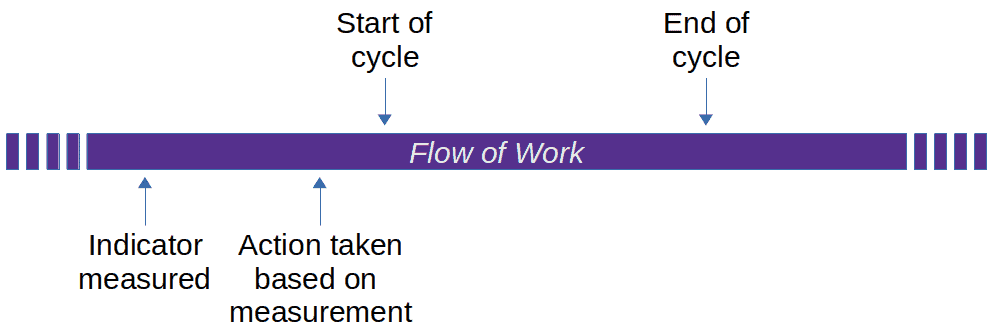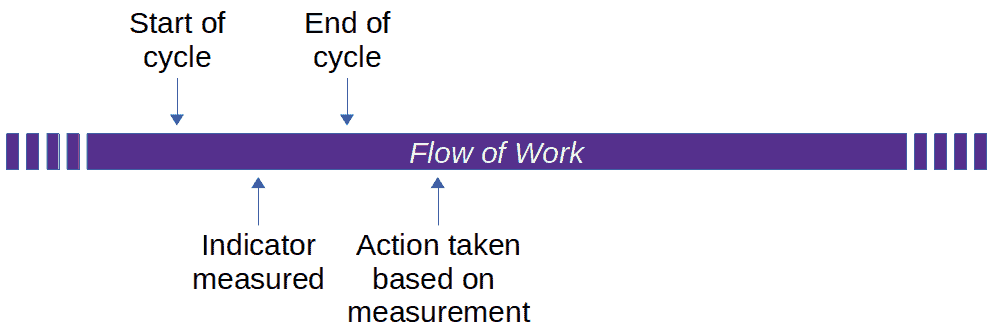Using the Kanban method leads us to rethink the indicators of performance and work management. Traditionally, we speak of lead indicators and lag indicators. But neither of these do justice to the essential benefit of Kanban allowing teams to improve how they work while they do the work. Thus, it is useful to speak of a third type of indicator: the along indicator.1
Suppose you are racing down a road in your car and come to an unexpectedly sharp bend. There is danger that you might not safely negotiate the curve.
Lead indicator: When you get into the car, your passenger says you should not drive too fast. You risk not being able to react in time to unpredictable conditions in the road. But, since your passenger is always nagging you about your driving, you may or may not pay attention.
 Along indicator: While you enter the curve, your passenger shouts “Slow down!”. If your reaction time is sufficient and the road is not too slippery, you brake enough to safely negotiate the bend.
Along indicator: While you enter the curve, your passenger shouts “Slow down!”. If your reaction time is sufficient and the road is not too slippery, you brake enough to safely negotiate the bend.
 Lag indicator: The police report about yet another fatal accident at that bend concluded that the car was going too fast. As a result, they had a large sign erected near the start of the bend saying “DANGEROUS CURVE AHEAD. SLOW DOWN!” Alas, that sign will bring neither the driver nor the passenger back to life.
Lag indicator: The police report about yet another fatal accident at that bend concluded that the car was going too fast. As a result, they had a large sign erected near the start of the bend saying “DANGEROUS CURVE AHEAD. SLOW DOWN!” Alas, that sign will bring neither the driver nor the passenger back to life.
The usefulness of the along indicator may be brought into relief by looking first at indicators used in the scrum method. Consider the sprint during which the team executes its value stream (or process) multiple times. Lead indicators are measured before the start of a sprint. Lag indicators are measured after the end of a sprint. As we shall see, I think it useful to speak of three indicators: lead, lag, along.
Lead Indicators
The story points associated with user stories exemplifies the lead indicator. Estimating story points provides an indicator of how much work should be planned for a sprint. On the other hand, velocity might exemplify a lag indicator, measuring the user stories the team completes during the sprint.
Lead indicators supposedly indicate how well an organization will likely perform. However, our VUCA world can severely limit the usefulness of such indicators. We make decisions using lead indicators as input, then perform actions based on those decisions. So often, the volatility of circumstances and the uncertainty of the lead indicators make those indicators less useful than desired. Lead indicators offer no guidance in addressing those unexpected changes that occur while the work is being done.
Lag Indicators

Wer nicht von dreitausend Jahren
Sich weiß Rechenschaft zu geben,
Bleib im Dunkeln unerfahren,
Mag von Tag zu Tage leben.
He who cannot draw on three thousand years is living in the dark from hand to mouth.
-Johann Wolfgang von Goethe
Lag indicators have the accuracy of 20-20 hindsight. Well, they do if the data selection is not too biased. And the calculation algorithm must be correct. And that algorithm must be applied correctly. And the indicator should be part of a balanced decision-making system.
As systems become more complex, consequently, deciders find it more difficult to predict the results of any change. Lag indicators reinforce the illusion that a change in the recent past causes the current state of a system. Such illusions may lead to Bermuda triangle-type phenomena.
The idea that the future is unpredictable is undermined every day by the ease with which the past is explained.
-Daniel Kahnemann
Lag indicators might be useful if teams exploit them in a PDCA-style improvement cycle:
- They do some work
- They measure what they have done (i.e., they measure lag indicators)
- They make some changes
- Return to step 1.
For some, improvers are always at least one cycle behind when they choose improvements based on lag indicators. If the work done in step 1 (above) has unsatisfactory results, lag indicators come too late to prevent the problem in the current process cycle. Using lag indicators to make decisions about the next cycle of work faces the same VUCA issues as lead indicators. Such use of indicators reminds us of the phenomenon of the general always fighting the last war.
Often, a lag indicator aggregates multiple measurements of multiple cycles of work. Such aggregation increases even more the lag between the activities measured and the supposed improvements based on those measurements.
Along Indicators

Carpe diem quam minimum credula postero.
Seize today and put as little trust as you can in the morrow.
-Quintus Horatius Flaccus
So, the question is whether we can find indicators that help us make decisions while work is being done. Can we make a difference in performance of the current process cycle, given the current circumstances, not the predicted circumstances in the future? This is where the Kanban method shines.
Take the example of cycle time, a typical lag indicator. More often than not, we seek to reduce mean cycle time for a given type of work. Kanban provides us with visual indicators of the current conditions that slow cycle time:
- blocked work items
- large queues
- bottlenecks
By themselves, such indicators do nothing to improve performance. Improvement might come when those indicators are input to a cadence of reviews, decisions and actions. Certain of these cadences are along cadences, whereas others are lag cadences.
The daily team meeting and any immediate follow-up actions exemplify the along cadence. They typically address the issue of blocked work items. Or certain bottlenecks might be addressed by an immediate re-balancing of how the team uses its resources.
But suppose you need to address a bottleneck by changing a team’s quantity of resources or by changing the value stream. Indicators aggregated over time support such decisions. A monthly or even quarterly cadence of such decisions addresses these aggregated indicators. While “number of days blocked for a single work item” might be an along indicator, “mean number of days blocked during the past month for all work items” might be a lag indicator.
Note that aggregation does not, by itself, determine whether an indicator is lag or along. For example, traditional project management measures whether a single project is on time and within budget, both classic lag indicators. And both are measured too late to make any difference for the project concerned. They remain lag indicators when aggregated.
A matter of scope and timing
The astute reader will have noticed that along indicators are measured after one or more events occur, like lag indicators. Technically, this is true. The difference between a lag indicator and a alonge indicator lay in the granularity of the work we measure. A alonge indicator is useful only if the cycle time is significantly longer than the time to measure the indicator and react to the measurement.
Let’s return to the analogy I provided at the start of this article.

Lead indicator: The scope of the indicator is too broad. It refers to your driving in general or to the entire trip. The indicator is not specifically tailored to the event of approaching a sharp bend in the road. Indeed, neither of you may have been thinking about the risk of unexpected sharp bends.
Along indicator: The indicator is tailored to the specific segment of the road on which you find yourself. It is communicated in such a way that the action to take is unmistakable and needs to be immediate.

Lag indicator: Like the along indicator, it concerns only the immediate segment of the road. It might have some impact on the behavior of future drivers. But it comes too late the mitigate the current situation. Indeed, prudent drivers or slow drivers might end up completely ignoring the sign. If one day the driver is in a particular hurry, the sign might have no impact.
Three Indicators: Lead, Lag, Along
Management methods promoting agility encourage patterns of behavior enabling along indicators. These methods emphasize the value of adapting the granularity of work items. When properly defined, a work item is sufficiently large to output something useful to clients while keeping the administrative overhead low. It is sufficiently small to be measurable with along indicators and to allow for changes in direction with a minimum of lost effort. At the same time, whether the work item is completed successfully or not, it is of a size the encourages learning from work experience.
I hope this discussion encourages you to seek out along indicators and make the three indicators—lead, lag, along—part of your continual improvement efforts.
![]() The article The Three Indicators by Robert S. Falkowitz, including all its contents, is licensed under a Creative Commons Attribution-NonCommercial-ShareAlike 4.0 International License.
The article The Three Indicators by Robert S. Falkowitz, including all its contents, is licensed under a Creative Commons Attribution-NonCommercial-ShareAlike 4.0 International License.
Credits
Unless otherwise indicated here, the diagrams are the work of the author.
Speedometer: By Bluescan sv.wiki – Own work, Public Domain, https://commons.wikimedia.org/w/index.php?curid=3457127
Figs. 1-3: The embedded image of the protractor is drawn from Scientif38 – Own work, CC0, https://commons.wikimedia.org/w/index.php?curid=12811448
Notes
1 In using the term “along” I attempt to preserve the alliteration of “lag” and “lead”. Terms like “while” and “during” are less happy. Other sources speak of “coincident indicators” (for example, https://www.investopedia.com/terms/c/coincidentindicator.asp). I hardly wish to give the impression that such indicators are coincidental.


Leave a Reply